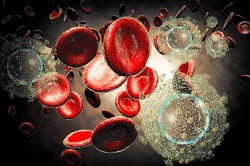Exploiting HIV’s weaknesses to develop effective vaccines
Around 6 300 people a day are infected by HIV, the virus that ultimately causes AIDS, whilst over 25 million people have so far died overall. Finding a vaccine has been the focal point of HIV research since the 1980s. Although this remains elusive, the success of a recent study suggests that scientists are on the right path. Part-funded through the ERC-funded SHEV project, the study, recently published in the journal ‘Cell Reports’, has identified a key vulnerability in the HIV molecule that could one day be targeted by an effective vaccine. Researchers are also confident that targeting a virus’s precise molecular structure – in order to prompt the immune system to produce specific antibodies – could also be applied to efforts to fight other viruses, such as influenza and Ebola viruses. The key is that every virus has a signature structure. Understanding the structure of HIV has enabled scientists to gain a better idea of exactly where HIV is vulnerable to infection-blocking antibodies. This is highly significant, because a major problem facing scientists has been the fact that HIV generally conceals vulnerable sites under a dense layer of sugars and fast-mutating parts. This is one reason why the virus has proven so difficult to neutralise; much of the body’s antibody response to infection is directed against fast-mutating parts that render the body’s response useless. A major step forward was the discovery of random holes in HIV’s protective outer shell of glycan molecules in the 1990s. Although scientists were initially unsure if antibodies could target these holes, this study has now confirmed that these holes could indeed be viable targets for antibodies, and thus play a crucial role in the design of an HIV vaccine. The findings build on work pioneered at Cornell, The Scripps Research Institute (TSRI) and the Academisch Medisch Centrum in Amsterdam, which coordinated the SHEV project. A stabilised version of an important HIV protein – called the envelope glycoprotein (Env) trimer – was designed in order to encourage rabbits to produce antibodies against the virus. The scientists then examined where the antibodies bound to the virus, revealing HIV’s vulnerabilities. They found that the antibodies did indeed target holes in the glycan shield of this protein, opening the door to possible future vaccines that encourage the immune system to create hole-targeting antibodies. While the SHEV project is due for completion at the end of 2016 EU-funded research in this field will continue. A key focus will be on evaluating possible vaccine candidates, and understanding the immune response induced by these vaccines. Much of this research will be financed by the EU’s European AIDS Vaccine Initiative (EAVI2020), which brings together leading HIV researchers from public organisations and biotech companies from across the world. The ultimate goal is to develop novel candidate vaccines that can be taken through to human trials within five years and provide a platform for discovering new vaccine candidates. The development of a protective vaccine remains the most attractive option for halting the global spread of HIV; around 34 million people are currently living with the virus. For further information please visit: SHEV project coordinator website project page on CORDIS
Countries
Netherlands



